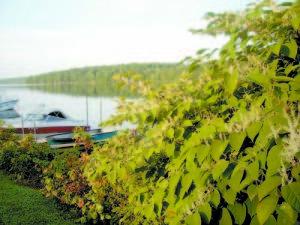Invaders: Some plants cause big problems

Japanese knotweed creates a barrier on the west side of Pleasant Lake. The knotweed is an aggressive invasive plant that can easily take over an area. (De Busk Photo)
By Dawn De Busk
Staff Writer
CASCO — An alien species thrives — stealing sunlight and water while growing bigger and broader. Then, it begins to choke and envelop the native species in its path.
It sounds like the beginnings of a horror movie.
For homeowners who take pride in their yards and gardens, it can be a battle to eradicate these invasive plants.
Nadia Hermos has been putting up a fight against the weeds, but often it seems to be a losing battle, she said. The popular burning bush (Euonymous Allata) with the dark red leaves is one of those transplants that has a tendency to take over the landscape, she said.
“Mine grew to be huge and deposited berries, and birds brought berries all over the woods and I’ve had to dig out those bushes,†she said.
Hermos discovered another weed — the purple loosestrife —by the Casco-Naples Transfer Site on Leech Hill Road.
“I snipped the blossoms so it wouldn’t spread, but I felt it was benefiting from pruning,†she said.
Hermos attributed the exceptionally rainy summer to an increased invasive plant problem.
In her capacity as the sole member of the Conservation Committee, Hermos would like to get information to the public about how dangerous invasive land plants can be for local species.
“We want to have a desirable landscape, it draws tourists here,†she said.
During a recent Casco Board of Selectmen meeting, invasive plants were the topic of conversation.
Earlier in the month, longtime summer resident Rona Fried took a walk with Town Manager Dave Morton and Chairman Mary-Vienessa Fernandes to see how well-rooted these invasive plants are around the public property in Casco Village.
Japanese knotweed creates a barrier on the west side of Pleasant Lake’s town beach. The Japanese knotweed has hollow stems like bamboo, and is very aggressive whenever land is cleared and at the edge of open spaces.
Another culprit is bittersweet nightshade, which is an aggressive vine with purple flowers and red berries. It has twisted its way around trees, fences and utility poles in the Village.
Fernandes said the plant tour was an eye-opener for her. After learning to identify a few of them, she was amazed to find more invasive plants in friends’ gardens and around town.
For now, information about these invasive plants and how to get rid of them will be posted on the town website under “hot topics.â€
At a later date, the town may decide to find a way to eradicate the bushes and vines before the native trees lose ground.
Hermos asked whether or not the town might entertain the idea of an ordinance to keep invasive plants at bay.
The board did not discuss any proposed ordinances during its meeting.
Fried, who operates Sustainable Business in New York, has been spending her summer on Pleasant Lake since she was a child. She was amazed to find the invasive vines and bushes thriving in Maine — thanks to an abundance of rain.
“The huge growth spurt is coming from Parker Pond to Mayberry Hill Road,†she said.
“In New York through New Hampshire, you don’t see trees anymore. You see a form that looks like a tree. But, the trees are covered with oriental bittersweet.
“The plant goes from tree to tree to tree.
Last year, for the first time, I saw it in Maine. It is slowly creeping up,†she said.
“Bittersweet and knotweed are very opportunistic. If land is disturbed or cleared, that takes over. We need to be aware of it. It is already in our forests,†she said.
According to Fried, the way to best kill it is to “stump cut it, leaving an inch so it is not touching the soil, but close to ground. Then, use a paint brush, and paint full-strength Roundup weed killer on the stump. Typically, I use organic pesticides, but this is the only way,†she said.
“We must do something about this plant. It is the milfoil on land,†Fried said.

